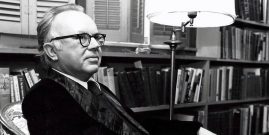What Kind of Humanism Do We Need?
A recent study by the Pew Forum revealed in great detail what even casual observation makes plain: Americans, like their European counterparts, are increasingly less religious than they used to be. Moreover, religious diversity is on the rise. As Western culture becomes more secular and more religiously diverse, it is interesting to wonder what holds it together. Can secular conceptions of human meaning provide a sufficient foundation for social life and political affiliation? The challenge of modernity and liberalism specifically, at least beginning with Hobbes, has been how human beings who share little more than common fear and common natural rights can live in community bound together by nothing higher than the mutual self-interest of physical well-being and autonomy.
The decline of the West has been measured, in part, by the rise of political ideologies and political religions that substitute for the classical and Judeao-Christian foundations of the Western tradition. At various points in the history of the West, resistance to modern ideologies has been provided by an array of individuals who in their poetry, fiction, statesmanship, and philosophy defend the older Western heritage. André Gushurst-Moore’s The Common Mind: Politics, Society and Christian Humanism from Thomas More to Russell Kirk, explains and defends how part of the Western heritage, Christian humanism, has provided resistance to the rise of modern political ideologies.
Gushurst-Moore is an English teacher and writer affiliated with the Downside School in Somerset, England. His review of Christian humanism is intended as a defense of “the tradition of Medieval Christendom” that brings to light the principles of Christian politics. He assumes that the medieval worldview is both recoverable and an appropriate antidote to the ills of modernity. He is a self-identified Christian conservative. The dozen thinkers covered in the book are “pillars of orthodoxy” whose articulation of the Christian humanist tradition can be part of contemporary efforts to restore the Christian foundations of Western civilization.
Beginning with Thomas More, Gushurst-Moore provides brief sketches of the contributions each thinker made to the Christian humanist vision that he crystallizes as the common mind. To the tradition of Christian humanism he juxtaposes a litany of modern ideological forces including “Islamist terrorism, militant atheism, global secularism, the exclusivity of state power, the culture of death, utilitarian education, an art of the abnormal, the continuing mechanization of human life.” Gushurst-Moore predicts an age of darkness if these ideological forces are left unchecked.
The introduction provides a brief description of the current state of Western culture that can be summarized as a loss of community resulting from the disintegration of traditional associations, a rise of vulgarity and violence, a loss of civility, and the rise of social engineering. The book does not devote much attention to diagnosing these forces of darkness; it instead is largely an examination of Christian humanism, a characterization of which unfolds over the course of explaining the orthodoxy of twelve thinkers. The analysis assumes a certain degree of knowledge about the causes of Western disorder and sympathy toward Christian humanism. The aim of the book is not to convert the unbelieving, but to bolster and encourage sympathetic readers who share similar concerns about the decline of the Christian West.
It was G.K. Chesterton who used the phrase “the common mind” to denote the collective sense of the human condition that binds all human beings as part of what it means to be human. The never-ending search for the meaning of human existence provides insights into the meaning of human nature including the relationship between human and divine reality. Humanism, in this sense, is the study of human nature and the meaning of human existence. What is learned from the common mind is that human nature is universal and unchanging. There is, then, an anti-utopian element to the philosophical substance of the common mind because it is inclined to reject as unrealistic conceptions of political, social, and economic life that do not account for the fallen nature of human beings. Such insights are accessible to all humans at the level of common sense in the way that Thomas Aquinas suggested that natural law could be known to reason.
While there is no universal political form that corresponds to the common mind, there has been in the Anglo-American tradition a tendency toward constitutional principles like limited government, separated powers, consent of the governed, the tension of rights and duties, and ordered liberty. Chapters on Edmund Burke and Benjamin Disraeli demonstrate the links between the insights of the human condition and politics. Here and throughout the book one notices the influence of Russell Kirk especially with regard to the importance of imagination and a rejection of global democracy.
Most of the thinkers covered in the book, including John Henry Newman and Orestes Brownson, are part of Kirk’s The Conservative Mind: From Burke to Eliot. Unlike Kirk, however, Gushurst-Moore rejects the New Humanism of Irving Babbitt as insufficiently Christian. Writing in the late nineteenth and early twentieth century, Babbitt diagnosed the Western crisis as a loss of ethical restraint that was ultimately rooted in the rejection of transcendent reality. He was just as apt to draw on the thinking of Aristotle, Buddha, or Christ. Gushurst-Moore, like Babbitt’s student T.S. Eliot, is unwilling to broaden the common mind beyond its medieval characteristics to encompass a humanism that restores the foundations of ethics without insisting on a specifically Christian or religious pedigree. It is worth considering the possibility of a more multi-faceted conservatism than Gushurst-Moore is willing to embrace.
Is it likely that a post-Christian culture will embrace Medieval Christian ideas without first returning to a more rudimentary acceptance of ethical realism? While Christians are likely to find common ground with much of The Common Mind, it would seem unrealistic to believe that widespread renewal of Christian humanism is possible in an age increasingly defined as secular. C. S. Lewis and Christopher Dawson, both whom Gushurst-Moore admires, did not hesitate to use Eastern sources to support their arguments about the human quest for meaning and spiritual nourishment. Why, then, dismiss Babbitt’s humanism?
The answer to this question may lie in a comment that Gushurst-Moore makes about Samuel Taylor Coleridge. In summarizing why Coleridge is an important figure in the restoration of Christian humanism, Gushurst-Moore writes: “The most hopeful facet of Coleridge’s life is that, in evil times, he inspired the revival of dogmatic and supernatural religion that became the saving grace of nineteenth-century England. It is difficult to think of anything that might benefit our times more than such a restoration.”
Babbitt, like the philosopher Eric Voegelin, was more than skeptical about the likelihood that dogmatic Christianity could or should be revived. Recognizing the challenges of the modern world, they placed their hope for spiritual renewal in the recovery of ethical and historical experience, something they considered primary to dogma or doctrine. Babbitt, for example, believed that it was possible to establish the reality of an ethically dualistic human nature on modern terms, without recourse to religious authority. Accepting the reality of man’s ethical nature on humanistic grounds was a prerequisite to the reestablishment of religious virtue. Lost religious authority would not be regained in an era defined by the individual’s liberation from it by reasserting medieval notions of spiritual authority. The renewal of moral realism depends on the incorporation of modern insights into the human condition.
Gushurst-Moore’s analysis does and does not recognize the need for synthesis. It draws too stark a contrast between the old and the new. He applauds Jonathan Swift for being “with the ancients and against the moderns.” Such a dichotomy would seem to suggest that there is nothing redeeming in modern thought, that the objective is to return to the old rather than to reconstitute it in light of the new. Yet, Gushurst-Moore’s analysis embraces Burke’s notion of moral imagination, something missing from ancient and medieval thought. What hope is there for a restoration of the old if all of modernity is to be rejected? It would seem worth considering the need for synthesis between ancient, medieval, and modern ideas. Gushurst-Moore does recognize the need for reinterpretation in new circumstances as well as an integrated vision and the need to reject the Middle Ages as a “template.” The tradition of Christian humanism, rather, serves as “a source of inspiration.”
Burke is fitting on the relationship between new and old: “in what we improve we are never wholly new; in what we retain we are never wholly obsolete.” Change is not only necessary to preserve the wisdom of the ages including long-established institutions and traditions, but when done in “the spirit of philosophic analogy” change maintains continuity between the old and the new. Traditions, customs, and institutions cannot stand in stagnant form and survive. They must find new ways to bring old truths to life. It is difficult to imagine Aquinas without Aristotle. It is worth noting that St. Thomas faced great resistance to the synthesis of Aristotle and Christian philosophy.
The book does an admirable job summarizing central aspects of the twelve thinkers covered. The intent is not to provide in-depth or comprehensive analysis to meet the interests of the expert. Rather, the objective is to reach a wider audience and to familiarize readers, who know little about it, with the tradition of Christian humanism. The book should be viewed as a starting point for those interested in deeper knowledge of Christian humanism. While a bibliography is included, the addition of an index and suggested readings would be useful tools for the beginning student.



